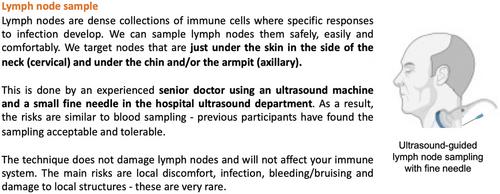Multi-site Ultrasound-guided Fine Needle Aspiration to Study Cells and Soluble Factors From Human Lymph Nodes
Adam Al-Diwani, Deepsha Agrawal, Fintan Sheerin, Callum Board, Sarosh R. Irani, Katrina M. Pollock, Nicholas M. Provine
{"title":"Multi-site Ultrasound-guided Fine Needle Aspiration to Study Cells and Soluble Factors From Human Lymph Nodes","authors":"Adam Al-Diwani, Deepsha Agrawal, Fintan Sheerin, Callum Board, Sarosh R. Irani, Katrina M. Pollock, Nicholas M. Provine","doi":"10.1002/cpz1.70063","DOIUrl":null,"url":null,"abstract":"<p>Lymph nodes (LNs) are specialized secondary lymphoid tissues essential to the priming and maintenance of adaptive immune responses, including the B cell germinal center response; thus, they are central to immunity. However, the anatomically restricted and time-resolved nature of immune priming means that sampling disease-relevant human LNs requires specialized techniques. This article describes the application of ultrasound-guided fine-needle aspiration (FNA) to sample LNs, using cervical LNs of the head and neck as an exemplar. This minimally invasive technique allows collection of both immune cells and cell-free material that are relevant to both neuroimmune diseases and basic lymphatic functions. Downstream use of cellular material can include multiplexed flow cytometry, single-cell transcriptome sequencing (RNA-seq), and B cell cultures. The cell-free supernatant can be used for proteomics or other similar ‘omics approaches. This unit describes collection of samples by FNA as well as processing and storage of samples for downstream assays. © 2024 The Author(s). Current Protocols published by Wiley Periodicals LLC.</p><p><b>Basic Protocol 1</b>: Sampling of human cervical lymph nodes by ultrasound-guided fine-needle aspiration</p><p><b>Alternate Protocol</b>: Sampling of human lymph nodes by ultrasound-guided fine-needle aspiration with negative pressure</p><p><b>Basic Protocol 2</b>: Processing and storage of human lymph node samples</p>","PeriodicalId":93970,"journal":{"name":"Current protocols","volume":"4 11","pages":""},"PeriodicalIF":0.0000,"publicationDate":"2024-11-23","publicationTypes":"Journal Article","fieldsOfStudy":null,"isOpenAccess":false,"openAccessPdf":"https://onlinelibrary.wiley.com/doi/epdf/10.1002/cpz1.70063","citationCount":"0","resultStr":null,"platform":"Semanticscholar","paperid":null,"PeriodicalName":"Current protocols","FirstCategoryId":"1085","ListUrlMain":"https://onlinelibrary.wiley.com/doi/10.1002/cpz1.70063","RegionNum":0,"RegionCategory":null,"ArticlePicture":[],"TitleCN":null,"AbstractTextCN":null,"PMCID":null,"EPubDate":"","PubModel":"","JCR":"","JCRName":"","Score":null,"Total":0}
引用次数: 0
Abstract
Lymph nodes (LNs) are specialized secondary lymphoid tissues essential to the priming and maintenance of adaptive immune responses, including the B cell germinal center response; thus, they are central to immunity. However, the anatomically restricted and time-resolved nature of immune priming means that sampling disease-relevant human LNs requires specialized techniques. This article describes the application of ultrasound-guided fine-needle aspiration (FNA) to sample LNs, using cervical LNs of the head and neck as an exemplar. This minimally invasive technique allows collection of both immune cells and cell-free material that are relevant to both neuroimmune diseases and basic lymphatic functions. Downstream use of cellular material can include multiplexed flow cytometry, single-cell transcriptome sequencing (RNA-seq), and B cell cultures. The cell-free supernatant can be used for proteomics or other similar ‘omics approaches. This unit describes collection of samples by FNA as well as processing and storage of samples for downstream assays. © 2024 The Author(s). Current Protocols published by Wiley Periodicals LLC.
Basic Protocol 1: Sampling of human cervical lymph nodes by ultrasound-guided fine-needle aspiration
Alternate Protocol: Sampling of human lymph nodes by ultrasound-guided fine-needle aspiration with negative pressure
Basic Protocol 2: Processing and storage of human lymph node samples

多部位超声引导细针抽吸法研究人体淋巴结的细胞和可溶性因子
淋巴结(LN)是特化的次级淋巴组织,对于启动和维持适应性免疫反应(包括 B 细胞生殖中心反应)至关重要;因此,淋巴结是免疫的核心。然而,免疫启动在解剖学上的局限性和时间分辨特性意味着,对与疾病相关的人类淋巴结进行取样需要专门的技术。本文以头颈部LN为例,介绍了超声引导下细针穿刺术(FNA)在LN取样中的应用。这种微创技术可收集与神经免疫疾病和基本淋巴功能相关的免疫细胞和无细胞材料。细胞材料的下游用途包括多重流式细胞术、单细胞转录组测序(RNA-seq)和 B 细胞培养。无细胞上清液可用于蛋白质组学或其他类似的 "omics "方法。本单元介绍了通过 FNA 收集样本以及处理和储存样本以用于下游检测的方法。© 2024 作者。当前协议》由 Wiley Periodicals LLC 出版。基本方案 1:通过超声引导下细针穿刺采集人体颈部淋巴结样本 备用方案:基本方案 2:处理和储存人体淋巴结样本。
本文章由计算机程序翻译,如有差异,请以英文原文为准。


